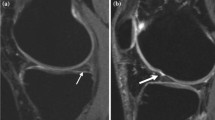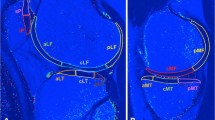Abstract
Purpose
To assess articular cartilage changes in the knee joint as detected on 3.0T MR imaging after 2-year follow-up in patients who underwent arthroscopic anterior cruciate ligament reconstruction (ACLR) with or without concomitant meniscal surgery.
Methods
A total of twenty-nine patients (mean age 30.3 ± 10 years), who underwent arthroscopic ACLR, received clinical and imaging follow-up at an average of 27.8 ± 4.8 months after surgery. Our patients were divided into two subgroups: eighteen patients with additional meniscal injuries at the time of arthroscopic ACLR who underwent meniscal surgery and eleven patients with intact menisci. The cartilage status of all knees at the time of arthroscopic ACLR was recorded. All patients underwent an MRI scan preoperatively and at follow-up with the same imaging protocol. Cartilage status of all knee compartments was evaluated at the time of follow-up by MR imaging and the ICRS classification.
Results
Deterioration of the cartilage status was found at all knee compartments of our study group, with respect to the number of cartilage defects. The cartilage of the lateral femoral condyle (LFC) was most severely affected, followed by patellar and medial femoral condyle (MFC) cartilage. A statistically significant relation was found between surgery of the medial meniscus and the development of new cartilage defects in LFC (p = 0.01) and MFC (p = 0.03) after adjusting for the site of meniscal surgery. The cartilage of LFC and the status of the medial meniscus were also found to be significantly related (p = 0.04). Partial meniscectomy was found to be associated with an increased incidence of new cartilage defects when compared to either meniscal repair or absence of meniscal surgery, although it was not statistically significant.
Conclusion
Development of new cartilage lesions was evident after 2-year follow-up in patients with arthroscopic ACLR as detected by MR imaging. There was a multicompartmental pattern of cartilage involvement, and the lateral compartment was most severely affected. Partial meniscectomy at the time of arthroscopic ACLR could be suggested as an additional risk factor for the progression of chondral lesions.
Level of evidence
Prospective comparative study, Level II.


Similar content being viewed by others
References
Ait Si Selmi T, Fithian D, Neyret P (2006) The evolution of osteoarthritis in 103 patients with ACL reconstruction at 17 years follow-up. Knee 13:353–358
Andreisek G, White LM, Sussman MS, Kunz M, Hurtig M, Weller I, Essue J, Marks P, Eckstein F (2009) Quantitative MR imaging evaluation of the cartilage thickness and subchondral bone area in patients with ACL-reconstructions 7 years after surgery. Osteoarthr Cartil 17:871–878
Bigoni M, Sacerdote P, Turati M, Franchi S, Gandolla M, Gaddi D, Moretti S, Munegato D, Augusti CA, Bresciani E, Omeljaniuk RJ, Locatelli V, Torsello A (2013) Acute and late changes in intraarticular cytokine levels following anterior cruciate ligament injury. J Orthop Res 31:315–321
Biswal S, Hastie T, Andriacchi TP, Bergman GA, Dillingham MF, Lang P (2002) Risk factors for progressive cartilage loss in the knee: a longitudinal magnetic resonance imaging study in forty-three patients. Arthritis Rheum 46:2884–2892
Brophy RH, Wright RW, David TS, McCormack RG, Sekiya JK, Svoboda SJ, Huston LJ, Haas AK, Steger-May K, Multicenter ACLRSG (2012) Association between previous meniscal surgery and the incidence of chondral lesions at revision anterior cruciate ligament reconstruction. Am J Sports Med 40:808–814
Carpenter RD, Majumdar S, Ma CB (2009) Magnetic resonance imaging of 3-dimensional in vivo tibiofemoral kinematics in anterior cruciate ligament-reconstructed knees. Arthroscopy 25:760–766
Chatain F, Adeleine P, Chambat P, Neyret P, Societe Francaise DA (2003) A comparative study of medial versus lateral arthroscopic partial meniscectomy on stable knees: 10-year minimum follow-up. Arthroscopy 19:842–849
Claes S, Hermie L, Verdonk R, Bellemans J, Verdonk P (2013) Is osteoarthritis an inevitable consequence of anterior cruciate ligament reconstruction? A meta-analysis. Knee Surg Sports Traumatol Arthrosc 21:1967–1976
Cohen M, Amaro JT, Ejnisman B, Carvalho RT, Nakano KK, Peccin MS, Teixeira R, Laurino CF, Abdalla RJ (2007) Anterior cruciate ligament reconstruction after 10 to 15 years: association between meniscectomy and osteoarthrosis. Arthroscopy 23:629–634
Englund M, Roos EM, Lohmander LS (2003) Impact of type of meniscal tear on radiographic and symptomatic knee osteoarthritis: a sixteen-year followup of meniscectomy with matched controls. Arthritis Rheum 48:2178–2187
Faber KJ, Dill JR, Amendola A, Thain L, Spouge A, Fowler PJ (1999) Occult osteochondral lesions after anterior cruciate ligament rupture. Six-year magnetic resonance imaging follow-up study. Am J Sports Med 27:489–494
Ferretti A, Monaco E, Labianca L, De Carli A, Maestri B, Conteduca F (2009) Double-bundle anterior cruciate ligament reconstruction: a comprehensive kinematic study using navigation. Am J Sports Med 37:1548–1553
Fithian DC, Paxton LW, Goltz DH (2002) Fate of the anterior cruciate ligament-injured knee. Orthop Clin North Am 33:621–636
Frobell RB (2011) Change in cartilage thickness, posttraumatic bone marrow lesions, and joint fluid volumes after acute ACL disruption: a two-year prospective MRI study of sixty-one subjects. J Bone Joint Surg Am 93:1096–1103
Georgoulis AD, Ristanis S, Chouliaras V, Moraiti C, Stergiou N (2007) Tibial rotation is not restored after ACL reconstruction with a hamstring graft. Clin Orthop Relat Res 454:89–94
Granan LP, Bahr R, Lie SA, Engebretsen L (2009) Timing of anterior cruciate ligament reconstructive surgery and risk of cartilage lesions and meniscal tears: a cohort study based on the Norwegian National Knee Ligament Registry. Am J Sports Med 37:955–961
Haughom B, Schairer W, Souza RB, Carpenter D, Ma CB, Li X (2012) Abnormal tibiofemoral kinematics following ACL reconstruction are associated with early cartilage matrix degeneration measured by MRI T1rho. Knee 19:482–487
Hayward AL, Deehan DJ, Aspden RM, Sutherland AG (2011) Analysis of sequential cytokine release after ACL reconstruction. Knee Surg Sports Traumatol Arthrosc 19:1709–1715
Hede A, Larsen E, Sandberg H (1992) Partial versus total meniscectomy. A prospective, randomised study with long-term follow-up. J Bone Joint Surg Br 74:118–121
Hosseini A, Van de Velde S, Gill TJ, Li G (2012) Tibiofemoral cartilage contact biomechanics in patients after reconstruction of a ruptured anterior cruciate ligament. J Orthop Res 30:1781–1788
Kawahara Y, Uetani M, Nakahara N, Doiguchi Y, Nishiguchi M, Futagawa S, Kinoshita Y, Hayashi K (1998) Fast spin-echo MR of the articular cartilage in the osteoarthrotic knee. Correlation of MR and arthroscopic findings. Acta Radiol 39:120–125
Kramer WC, Hendricks KJ, Wang J (2011) Pathogenetic mechanisms of posttraumatic osteoarthritis: opportunities for early intervention. Int J Clin Exp Med 4:285–298
Lee YS, Jeong YM, Sim JA, Kwak JH, Kim KH, Nam SW, Lee BK (2013) Specific compartmental analysis of cartilage status in double-bundle ACL reconstruction patients: a comparative study using pre- and postoperative MR images. Knee Surg Sports Traumatol Arthrosc 21:702–707
Li H, Chen S, Tao H, Chen S (2015) Quantitative MRI T2 relaxation time evaluation of knee cartilage: comparison of meniscus-intact and -injured knees after anterior cruciate ligament reconstruction. Am J Sports Med 43:865–872
Li X, Kuo D, Theologis A, Carballido-Gamio J, Stehling C, Link TM, Ma CB, Majumdar S (2011) Cartilage in anterior cruciate ligament-reconstructed knees: MR imaging T1{rho} and T2–initial experience with 1-year follow-up. Radiology 258:505–514
Magnussen RA, Mansour AA, Carey JL, Spindler KP (2009) Meniscus status at anterior cruciate ligament reconstruction associated with radiographic signs of osteoarthritis at 5- to 10-year follow-up: a systematic review. J Knee Surg 22:347–357
Neuman P, Tjornstrand J, Svensson J, Ragnarsson C, Roos H, Englund M, Tiderius CJ, Dahlberg LE (2011) Longitudinal assessment of femoral knee cartilage quality using contrast enhanced MRI (dGEMRIC) in patients with anterior cruciate ligament injury–comparison with asymptomatic volunteers. Osteoarthr Cartil 19:977–983
Noyes FR, Chen RC, Barber-Westin SD, Potter HG (2011) Greater than 10-year results of red-white longitudinal meniscal repairs in patients 20 years of age or younger. Am J Sports Med 39:1008–1017
Papathanasiou I, Michalitsis S, Hantes ME, Vlychou M, Anastasopoulou L, Malizos KN, Tsezou A (2016) Molecular changes indicative of cartilage degeneration and osteoarthritis development in patients with anterior cruciate ligament injury. BMC Musculoskelet Disord. doi:10.1186/s12891-016-0871-8
Paxton ES, Stock MV, Brophy RH (2011) Meniscal repair versus partial meniscectomy: a systematic review comparing reoperation rates and clinical outcomes. Arthroscopy 27:1275–1288
Pena E, Calvo B, Martinez MA, Palanca D, Doblare M (2006) Why lateral meniscectomy is more dangerous than medial meniscectomy. A finite element study. J Orthop Res 24:1001–1010
Potter HG, Jain SK, Ma Y, Black BR, Fung S, Lyman S (2012) Cartilage injury after acute, isolated anterior cruciate ligament tear: immediate and longitudinal effect with clinical/MRI follow-up. Am J Sports Med 40:276–285
Roemer FW, Crema MD, Trattnig S, Guermazi A (2011) Advances in imaging of osteoarthritis and cartilage. Radiology 260:332–354
Roos H, Adalberth T, Dahlberg L, Lohmander LS (1995) Osteoarthritis of the knee after injury to the anterior cruciate ligament or meniscus: the influence of time and age. Osteoarthr Cartil 3:261–267
Scarvell JM, Smith PN, Refshauge KM, Galloway HR, Woods KR (2006) Does anterior cruciate ligament reconstruction restore normal knee kinematics?: A prospective MRI analysis over two years. J Bone Joint Surg Br 88:324–330
Shi DL, Wang YB, Ai ZS (2010) Effect of anterior cruciate ligament reconstruction on biomechanical features of knee in level walking: a meta-analysis. Chin Med J (Engl) 123:3137–3142
Simon D, Mascarenhas R, Saltzman BM, Rollins M, Bach BR Jr, MacDonald P (2015) The relationship between anterior cruciate ligament injury and osteoarthritis of the knee. Adv Orthop. doi:10.1155/2015/928301
Stergiou N, Ristanis S, Moraiti C, Georgoulis AD (2007) Tibial rotation in anterior cruciate ligament (ACL)-deficient and ACL-reconstructed knees: a theoretical proposition for the development of osteoarthritis. Sports Med 37:601–613
Theologis AA, Haughom B, Liang F, Zhang Y, Majumdar S, Link TM, Ma CB, Li X (2014) Comparison of T1rho relaxation times between ACL-reconstructed knees and contralateral uninjured knees. Knee Surg Sports Traumatol Arthrosc 22:298–307
Vlychou M, Hantes M, Michalitsis S, Tsezou A, Fezoulidis IV, Malizos K (2011) Chronic anterior cruciate ligament tears and associated meniscal and traumatic cartilage lesions: evaluation with morphological sequences at 3.0 T. Skeletal Radiol 40:709–716
Wang X, Wang Y, Bennell KL, Wrigley TV, Cicuttini FM, Fortin K, Saxby DJ, Van Ginckel A, Dempsey AR, Grigg N, Vertullo C, Feller JA, Whitehead T, Lloyd DG, Bryant AL (2015) Cartilage morphology at 2-3 years following anterior cruciate ligament reconstruction with or without concomitant meniscal pathology. Knee Surg Sports Traumatol Arthrosc. doi:10.1007/s00167-015-3831-1
Weninger P, Zifko B, Liska M, Spitaler R, Pelinka H, Hertz H (2008) Anterior cruciate ligament reconstruction using autografts and double biodegradable femoral cross-pin fixation: functional, radiographic and MRI outcome after 2-year minimum follow-up. Knee Surg Sports Traumatol Arthrosc 16:988–995
Wong S, Steinbach L, Zhao J, Stehling C, Ma CB, Link TM (2009) Comparative study of imaging at 3.0 T versus 1.5 T of the knee. Skeletal Radiol 38:761–769
Yoshioka H, Stevens K, Hargreaves BA, Steines D, Genovese M, Dillingham MF, Winalski CS, Lang P (2004) Magnetic resonance imaging of articular cartilage of the knee: comparison between fat-suppressed three-dimensional SPGR imaging, fat-suppressed FSE imaging, and fat-suppressed three-dimensional DEFT imaging, and correlation with arthroscopy. J Magn Reson Imaging 20:857–864
Author information
Authors and Affiliations
Corresponding author
Ethics declarations
Conflict of interest
None.
Rights and permissions
About this article
Cite this article
Michalitsis, S., Hantes, M., Thriskos, P. et al. Articular cartilage status 2 years after arthroscopic ACL reconstruction in patients with or without concomitant meniscal surgery: evaluation with 3.0T MR imaging. Knee Surg Sports Traumatol Arthrosc 25, 437–444 (2017). https://doi.org/10.1007/s00167-016-4153-7
Received:
Accepted:
Published:
Issue Date:
DOI: https://doi.org/10.1007/s00167-016-4153-7




